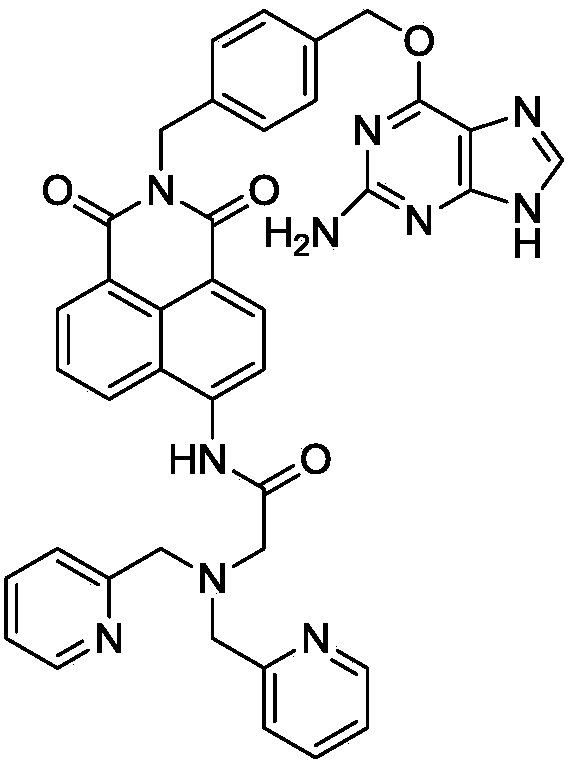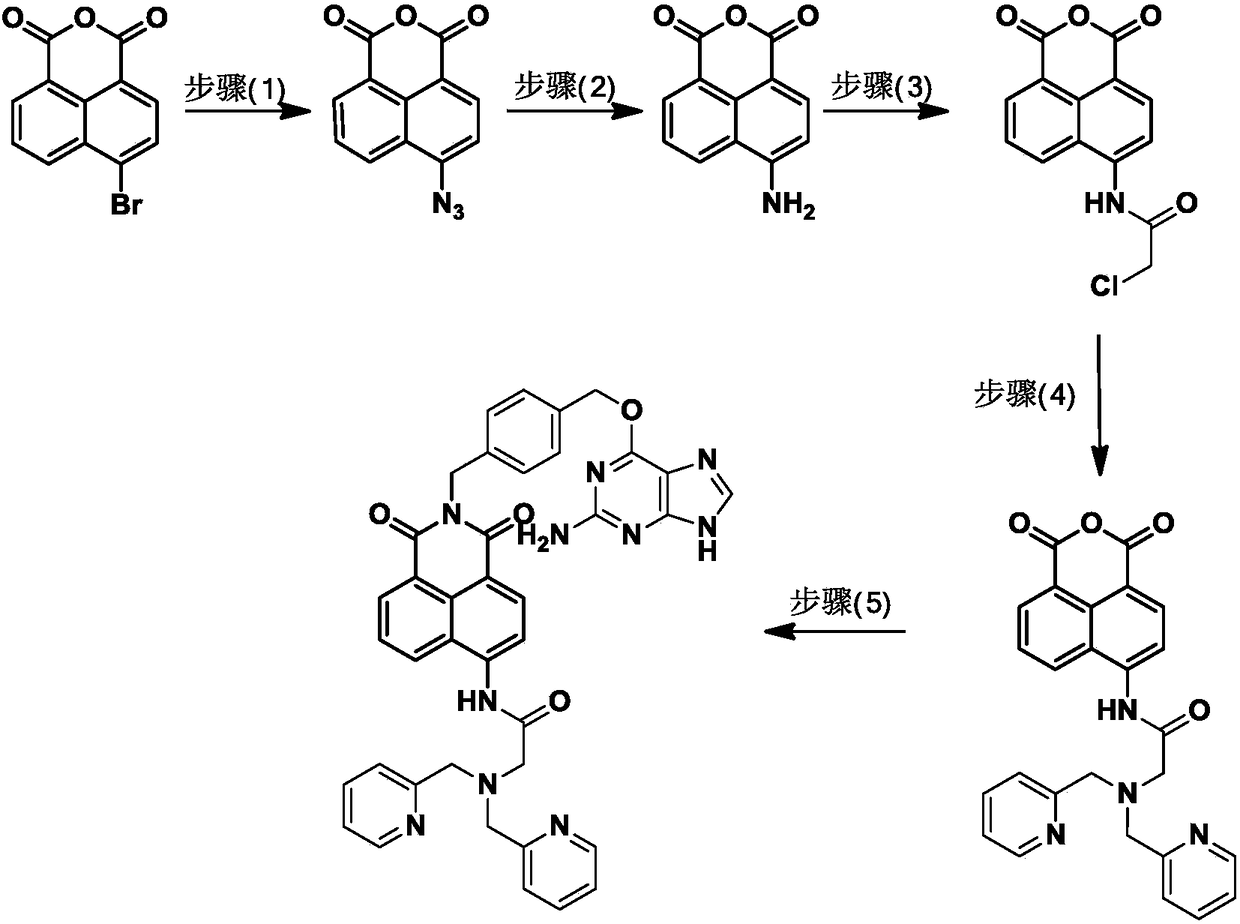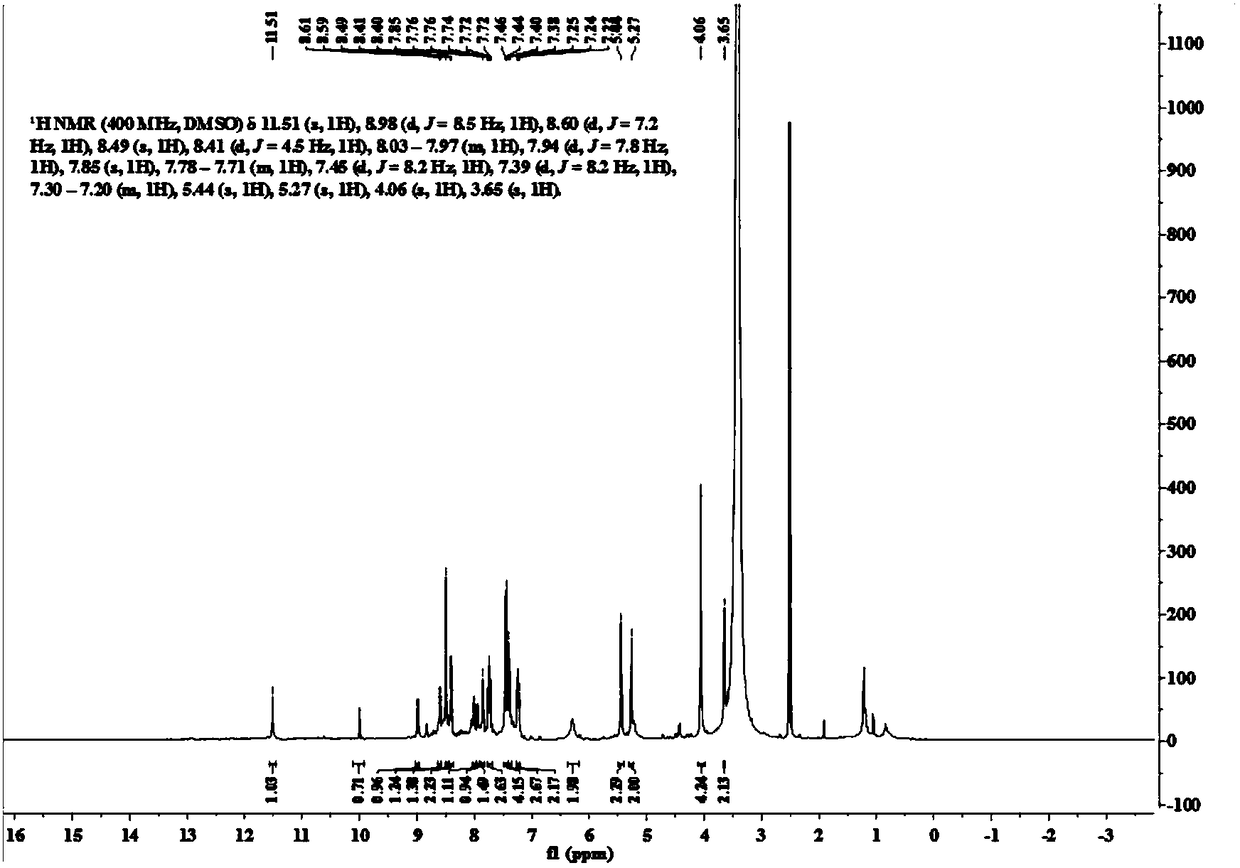Fluorescent probe for intracellular protein labelling as well as synthesis method and application of fluorescent probe
A technology of fluorescent probe and synthesis method, which is applied to the fluorescent probe for intracellular protein labeling and its synthesis and application fields, can solve the problems of inability to achieve satisfactory results, reduced cell permeability, long incubation time, etc., and achieves important goals. The effect of application value, good photostability and simple steps
- Summary
- Abstract
- Description
- Claims
- Application Information
AI Technical Summary
Problems solved by technology
Method used
Image
Examples
Embodiment 1
[0048] Example 1: Synthesis of novel fluorescent probes for protein labeling.
[0049] Synthesis of intermediate 4-azido-1,8-naphthalene anhydride:
[0050] 4-Bromo-1,8-naphthalene anhydride (2.5 g, 9 mmol) was placed in a 100 mL one-necked flask, and 20 mL of N,N-dimethylformamide was added. Sodium azide (1.8g, 27.7mmol) was dissolved in 3.5mL of water and added dropwise to the reaction solution, heated to 100°C for 6h, cooled, poured into ice water for suction filtration, and dried in vacuo to obtain 2g of a dark yellow solid, yielding The rate is 92%.
[0051]Synthesis of intermediate 4-amino-1,8-naphthalene anhydride:
[0052] 4-Azido-1,8-naphthalene anhydride (1.8 g, 7.6 mmol) was dissolved in 100 mL of acetonitrile, and sodium sulfide nonahydrate (6.5 g, 41 mmol) was added. Heating to 60° C. for 10 h, cooling, pouring into ice water, suction filtration, and vacuum drying gave 1.3 g of a yellow solid with a yield of 80%.
[0053] Synthesis of intermediate 4-(2-chloroa...
Embodiment 2
[0060] Example 2: MALDI-TOF mass spectrometry before and after the probe reacts with the SNAP protein
[0061] Add 7.5 μL of probe solution (the mother solution is 2 mM DMSO solution) to 1 mL of SNAP protein containing 5 μM, 20 mM, pH=7.4 in PBS solution, stir at 37 ° C, and use an 8000 Da dialysis bag at 20 mM, pH=7.4 after 2 hours Dialyze in PBS solution to remove excess probes, take 10 μL of reaction solution and 10 μL SNAP protein for MALDI-TOF-MS respectively.
[0062] Figure 5 It shows that the molecular weight of SNAP protein is 21634.03, and a single peak appears in MALDI-TOF-MS after reacting with the fluorescent probe, which proves that the SNAP protein reacts completely, and the molecular weight is 22187.52, which is the same molecular weight as the reaction product of SNAP protein and probe in theory. Demonstrate that the SNAP protein covalently reacts with the probe.
Embodiment 3
[0063] Example 3: Fluorescence spectra before and after the probe reacts with the SNAP protein
[0064] Add 1 μL probe mother solution to 5 μM, 2 mL SNAP protein PBS solution, react at 37 ° C for 1 h, and then detect its fluorescence spectrum, and use the fluorescence spectrum of unreacted 1 μM probe as a control.
[0065] Figure 6 The concentration of the fluorescent probes in the medium was 1 μM, and after the probes reacted with the SNAP protein, the ~ The fluorescence intensity at 510nm was significantly enhanced, about 10 times.
PUM
 Login to View More
Login to View More Abstract
Description
Claims
Application Information
 Login to View More
Login to View More - R&D
- Intellectual Property
- Life Sciences
- Materials
- Tech Scout
- Unparalleled Data Quality
- Higher Quality Content
- 60% Fewer Hallucinations
Browse by: Latest US Patents, China's latest patents, Technical Efficacy Thesaurus, Application Domain, Technology Topic, Popular Technical Reports.
© 2025 PatSnap. All rights reserved.Legal|Privacy policy|Modern Slavery Act Transparency Statement|Sitemap|About US| Contact US: help@patsnap.com



